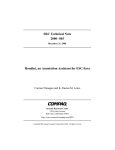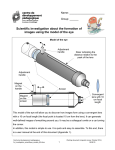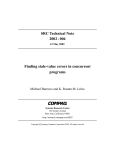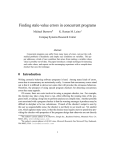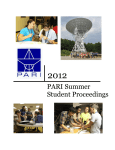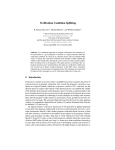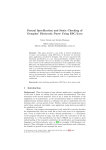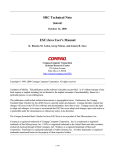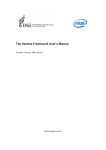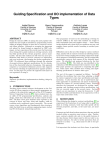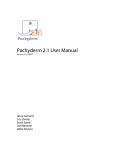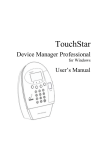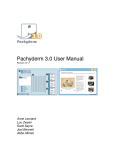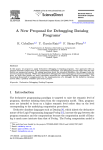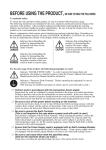Download Houdini, an Annotation Assistant for ESC/Java
Transcript
Houdini, an Annotation Assistant for ESC/Java
Cormac Flanagan and K. Rustan M. Leino
Compaq Systems Research Center
130 Lytton Ave., Palo Alto, CA 94301, USA
{cormac.flanagan,rustan.leino}@compaq.com
Abstract. A static program checker that performs modular checking
can check one program module for errors without needing to analyze the
entire program. Modular checking requires that each module be accompanied by annotations that specify the module. To help reduce the cost
of writing specifications, this paper presents Houdini, an annotation assistant for the modular checker ESC/Java. To infer suitable ESC/Java
annotations for a given program, Houdini generates a large number of
candidate annotations and uses ESC/Java to verify or refute each of
these annotations. The paper describes the design, implementation, and
preliminary evaluation of Houdini.
0
Introduction
The Compaq Extended Static Checker for Java (ESC/Java) is a tool for finding defects in Java programs [3, 12, 7, 13]. It relies on the programmer to supply
annotations describing program properties such as method preconditions, postconditions, and object invariants. These annotations allow ESC/Java to catch
software defects using a method-local analysis. During this analysis, ESC/Java
verifies that the annotations are consistent with the program, and it also uses
the annotations to verify that each primitive operation (such as a dereference
operation) will not raise a run-time exception (as might happen, for example, if
a dereferenced pointer is null).
Other static checkers that follow this modular approach include conventional
type checkers, which rely on type annotations to guide the type checking process,
and rccjava [5], a static race condition checker, which relies on annotations
describing the locking discipline.
A limitation of the modular checking approach is the burden on the programmer to supply annotations. Although programmers have grown accustomed to
writing type annotations, they have been reluctant to provide additional annotations. In our experience, this reluctance has been the major obstacle to the
adoption of ESC/Java. This annotation burden appears particularly pronounced
when faced with the daunting task of applying ESC/Java to an existing (unannotated) code base.
To make ESC/Java more useful in catching defects in legacy code, we have
developed Houdini, an annotation assistant that infers suitable ESC/Java annotations for an unannotated program. Houdini reuses ESC/Java as a subroutine
2
C. Flanagan, K.R.M. Leino
when inferring these annotation. Essentially, Houdini conjectures a large number
of possible candidate annotations, and then uses ESC/Java to verify or refute
each of these annotations.
This paper describes the design, implementation, and preliminary evaluation
of Houdini. Our experience indicates that this approach is capable of inferring
many useful annotations. These annotations significantly reduce the number of
false alarms produced by ESC/Java (as compared with checking the original,
unannotated program), and we have found that using Houdini reduces the programmer time required to statically catch defects in unannotated programs.
The presentation of our results proceeds as follows. The following section
starts by reviewing ESC/Java. Section 2 introduces the basic architecture of
Houdini. Section 3 describes the heuristics for generating candidate annotations.
Section 4 describes how Houdini handles libraries. Section 5 describes Houdini’s
user interface. Section 6 describes our experience using Houdini to catch defects
in four test programs totaling 50,000 lines of code. Houdini is actually a thirdgeneration annotation assistant; Section 7 outlines some prior approaches we
have tried. Section 8 describes related work, and we conclude in Section 9.
1
Review of ESC/Java
ESC/Java is a tool for finding common programming errors in Java programs. It
takes as input a Java program, possibly annotated with ESC/Java light-weight
specifications, and produces as output a list of warnings of possible errors in
the program. Because of its static and automatic nature, its use is reminiscent
of that of a type checker. Under the hood, however, ESC/Java is powered by a
more precise semantics engine and an automatic theorem prover.
ESC/Java performs modular checking: Every routine (method or constructor) is given a specification. ESC/Java checks that the implementation of each
routine meets its specification, assuming that all routines called meet their specifications. The specification comes from user-supplied annotations. Note that
ESC/Java does not trace into the code of a callee, even if the callee code is also
given to the tool to be checked. By performing modular checking, ESC/Java can
be applied to a class, or even a routine, at a time, without needing the entire
program.
Figure 0 shows a simple Java class that demonstrates the use of typical
ESC/Java annotations. The class implements an n-tuple of non-null values (of
type Object), where n can be changed over the lifetime of the object. The
constructor creates an empty tuple and the put method sets element j of the
tuple to the given value p, extending the tuple size by 1 if j==n, and returning
the previous value, if any, of this tuple element.
ESC/Java annotations are given as specially formatted Java comments. If
the first character within the Java comment is an @-sign, ESC/Java parses the
comment and expects to find legal annotations. The expressions occurring in
ESC/Java annotations are mostly just side-effect free Java expression, but with
Houdini, an Annotation Assistant for ESC/Java
3
class Tuple {
int n;
//@ invariant 0 <= n;
Tuple() { ... }
// constructor
//@ requires 0 <= j;
//@ requires j <= n;
//@ requires p != null;
//@ ensures j == n || \result != null;
Object put(int j, Object p) { ... }
...
Object a[];
//@ invariant a != null;
//@ invariant (\forall int i; 0 <= i && i < n ==> a[i] != null);
//@ invariant n <= a.length;
}
Fig. 0. Examples of typical ESC/Java annotations
some additions, including quantified expressions and some special keywords and
functions.
The example in Figure 0 shows the put method to have some pre- and postconditions. The requires keyword declares a precondition and the ensures
keyword declares a postcondition. The occurrences of j and p in these annotations refer to the method’s parameters and n refers to the field declared in the
class. The postcondition uses the special keyword \result to refer to the value
returned by the method. Since this is a light-weight specification, it does not
specify all aspects of the method’s behavior.
The example also shows several declarations of object invariants. ESC/Java
checks that these are established by the constructor and maintained by other
routines. (The details are described in the ESC/Java user’s manual [12].) One
of the invariant declarations uses a universal quantification and the ESC/Java
implication operator ==>.
To make ESC/Java simpler, it contains some degree of unsoundness by design. That is, it sometimes fails to detect genuine errors. In practice, this limitation does not negatively affect the usefulness of ESC/Java. Also, since the
properties that it attempts to check are undecidable in the worst case, ESC/Java
is also incomplete and may produce spurious warnings.
2
Houdini architecture
Although ESC/Java works well on annotated programs, catching defects in
legacy, unannotated programs using ESC/Java is an arduous process. It is pos-
4
C. Flanagan, K.R.M. Leino
sible to run ESC/Java on an unannotated program, but this produces an excessively large number of false alarms. Alternatively, one can manually insert
appropriate annotations into the program, but this is a very time-consuming
task for large programs. Preliminary experience with ESC/Java indicates that
a programmer can annotate an existing, unannotated program at the rate of
a few hundred lines per hour, or perhaps at a lower rate if the programmer is
unfamiliar with the code.
Therefore, we would like to automate much of the annotation process by
developing an annotation assistant that infers suitable ESC/Java annotations for
a legacy, unannotated program. The following Houdini algorithm implements an
annotation assistant. This algorithm leverages off ESC/Java’s ability to perform
precise method-local analysis.
Input : An unannotated program P
Output : ESC/Java warnings for an annotated version of P
Algorithm:
generate set of candidate annotations and insert into P;
repeat
invoke ESC/Java to check P;
remove any refuted candidate annotations from P;
until quiescence;
invoke ESC/Java to identify possible defects in P;
The first step in the algorithm is to generate a finite set of candidate annotations. This set is generated from the program text based on heuristics about
what annotations might be useful in reasoning about the program’s behavior.
For example, since a common precondition in manually-annotated programs is
that an argument of reference type is non-null, the candidate annotation set
includes all preconditions of this form. Other useful heuristics for guessing candidate annotations are described in Section 3.
Many of the candidate annotations will of course be incorrect. To identify
these incorrect annotations, the Houdini algorithm invokes ESC/Java on the annotated program. Like any invocation of ESC/Java, this invocation may produce
two kinds of warnings. The first kind concerns potential run-time errors, such
as dereferencing the null pointer. These warnings are ignored by the Houdini
algorithm.
The second kind of warning concerns invalid annotations. During the checking
process, ESC/Java may discover that the property expressed by an annotation
may not hold at a particular program point (for example, a method precondition
may not hold at a call site of the method). The annotation assistant interprets
such warnings as refuting incorrect guesses in the candidate annotation set, and
removes these refuted annotations from the program text.
Since removing one annotation may cause subsequent annotations to become
invalid, this check-and-refute cycle iterates until a fixpoint is reached. This process terminates, because until a fixpoint is reached, the number of remaining
candidate annotations is strictly decreased with each iteration. The resulting
Houdini, an Annotation Assistant for ESC/Java
5
annotation set is clearly a subset of the candidate set, and is valid with respect
to ESC/Java, that is, ESC/Java does not refute any of its annotations. The
inferred annotation set is in fact a maximal valid subset of the candidate set.
Furthermore, this maximal subset is unique. For a proof of these properties, and
also a more efficient version of the basic algorithm presented here, we refer the
interested reader to our companion paper [6].
Note that the Houdini algorithm works also for recursive methods. The candidate preconditions of a recursive method will be refined (by removing refuted
preconditions) until the resulting set of preconditions holds at all call sites of
the method, both recursive and non-recursive call sites.
After the check-and-refute loop terminates, the final step in the Houdini
algorithm is to run ESC/Java one more time to identify potential run-time errors
in the (now annotated) program. These warnings are then presented to the user,
and are used as a starting point in identifying defects in the program.
3
Generating the candidate annotation set
The usefulness of the inferred annotations depends crucially on the initial candidate annotation set. Ideally, the candidate set should include all annotations that
are likely to be useful in reasoning about the program’s behavior. However, the
candidate set should not be too large, because this would increase the running
time of the algorithm. Based on an inspection of a variety of hand-annotated
programs and on our experience with ESC/Java and Houdini, we have developed
the following heuristics for generating candidate annotations.
For any field f declared in the program, we guess the following candidate
invariants for f:
Type of f
integral type
Candidate invariants for f
//@ invariant f cmp expr ;
reference type
//@ invariant f != null;
array type
//@ invariant f != null;
//@ invariant \nonnullelements(f);
//@ invariant (\forall int i; 0 <= i && i < expr
==> f[i] != null);
//@ invariant f.length cmp expr ;
boolean
//@ invariant f == false;
//@ invariant f == true;
Many of these candidate invariants are intended to help verify the absence of
index-out-of-bounds errors. For each integral field f we guess several inequalities relating f to other integral fields and constants. The comparison operator
cmp ranges over the six operators <, <=, ==, !=, >=, and >, and expr is either
6
C. Flanagan, K.R.M. Leino
an integral field declared earlier in the same class or an interesting constant.
Interesting constants include the numbers -1, 0, 1, and also constant dimensions
used in array allocation expressions (e.g., new int[4]). For each field f of an
array type, we also guess a number of inequalities regarding f.length. Although
some of these inequalities are more useful than others, we include all of them for
completeness.
Some of these guessed invariants are mutually inconsistent. For example, if
a class declares an integral field f we will guess several invariants, including:
//@ invariant f < 0;
//@ invariant f >= 0;
Such inconsistent guesses do not cause a problem. When checking a constructor
for the class, ESC/Java will refute at least one of these invariants, since the
constructed instance cannot simultaneously satisfy both invariants.
We also guess candidates invariants that help verify the absence of null dereference errors. For each field f of a reference type, we guess f != null. For each
field f of an array type, in addition to guessing the invariant f != null, we
also guess the invariant \nonnullelements(f), which states that each entry in
the array is not null, and we guess an invariant that all entries in f up to expr
(a field or an interesting constant) are not null. We have found this last property to be useful in reasoning about the behavior of stack-like data structures
implemented using arrays.
We generate candidate preconditions and postconditions in a similar manner
for each routine declared in the program. Candidate preconditions may include
inequalities relating two argument variables, or relating an argument variable
to a field declared in the same class. Candidate postconditions may relate the
result variable \result to either argument variables or fields. In addition, we
generate the candidate postcondition
//@ ensures \fresh(\result);
which states that the result of a method is a newly-allocated object, and hence
not an alias of any previously existing object.
As an aid in identifying dead code, we generate the candidate annotation
//@ requires false;
for every routine in the program. An unrefuted requires false annotation
indicates that the corresponding routine is never called.
For correctness reasons, we require that all applicable candidate annotations
hold in the program’s initial state. Hence, for the program entry point
public static void main(String args[]) { ... }
we only generate the following precondition, which is ensured by the Java runtime system:
//@ requires \nonnullelements(args);
Houdini, an Annotation Assistant for ESC/Java
4
7
Dealing with libraries
So far, we have described Houdini as a system that infers annotations based on
an analysis of the entire program. However, the program may be linked with a
library (or with several libraries) that we cannot analyze, either because we do
not have source code for the library or because the size of the library makes the
analysis impractical.
If the library in question already includes ESC/Java annotations that specify
its interface, or if we are willing to write such an interface specification, then
it is straightforward to adapt the Houdini algorithm to analyze and annotate
the remainder of the program with respect to this specification. In many cases,
however, the size and complexity of the library makes writing an interface specification quite tedious. Hence, we would like to be able to infer annotations for
a program even in the absence of ESC/Java specifications for all of the libraries
used by the program.
Therefore, we extend Houdini so that it can analyze a program with respect
to guessed specifications for these libraries. There are two main strategies for
guessing library specifications. The first strategy is to make pessimistic assumptions, for example, that all pointers returned by library methods may be null.
Since many of these pointers will never be null, such pessimistic specifications
cause Houdini to produce a large number of false alarms in the rest of the program, and we have not found this approach cost-effective for static debugging.
(ESC/Java provides pessimistic assumptions by default in the absence of library
annotations.)
An alternative strategy is to make optimistic assumptions about the behavior
of libraries, for example, that all pointers returned by library methods will be
non-null. Since some of these pointers may sometimes be null, this assumption
is unsound, and may cause Houdini to miss certain run-time errors. However, in
library clients, Houdini will still detect many other run-time errors, and since
the optimistic specifications lead to many fewer false alarms, this appears to be
a more cost-effective strategy for guessing library specifications.
For libraries, we need to be careful not to guess contradictory annotations.
To illustrate this idea, suppose that we generated the two contradictory postconditions
//@ ensures \result < 0;
//@ ensures \result >= 0;
for a library method that the program does not override. Since the implementation of the library method is not checked, neither of these guessed annotations
will be refuted. ESC/Java would then infer that the method never returns and
would not check code following a call to this method. Therefore, we only guess
the following consistent postconditions for each library method:
8
C. Flanagan, K.R.M. Leino
Result type
integral type
Optimistic postconditions
//@ ensures \result >= 0;
reference type
//@ ensures \result != null;
array type
//@ ensures \result != null;
//@ ensures \nonnullelements(\result);
We guess optimistic preconditions and invariants in a similar manner.
The modified Houdini algorithm for dealing with libraries is as follows:
Input : An unannotated program P
A set of libraries S with specifications
A set of libraries L without specifications
Output : ESC/Java warnings for an annotated version of P
Algorithm:
generate and insert candidate annotations into P;
generate and insert optimistic annotations into L;
repeat
invoke ESC/Java to check P with respect to L and S;
remove any refuted candidate annotations from P;
remove any refuted optimistic annotations from L;
until quiescence;
invoke ESC/Java to identify possible defects in P with respect to L and S;
5
User interface
To catch defects using Houdini, a user starts by inspecting Houdini’s output,
which includes the set of warnings that ESC/Java produces for the annotated
version of the program. Unlike using ESC/Java, where a warning in one routine
often points to a problem with that routine’s implementation or specification,
the warnings produced by Houdini are more often caused by some other part
of the program. For example, suppose one of the warnings points out a possible
null dereference of t in the following method:
char getFirstChar(String t) { return t.charAt(0); }
A user’s first reaction might be: But I only intend getFirstChar to be called
with non-null arguments! The ESC/Java user would then add the precondition
t != null, which suppresses the spurious warning. (This precondition is then
checked at call sites.) But the Houdini user will instead ask: Why didn’t Houdini
infer this precondition?
In our experience with looking at Houdini output, we constantly asked questions such as these. We developed a simple user interface to help answer these
questions. The user interface generates a collection of HTML pages. The root
Houdini, an Annotation Assistant for ESC/Java
9
page of this collection presents a summary of the kinds of warnings that the
final call to ESC/Java produces, followed by the actual list of warning messages.
Each warning message contains a hyperlink to the source view of the code at the
location of the offending program line.
In the source code view (shown in Figure 1), the user interface displays all of
the candidate annotations guessed by Houdini. A refuted annotation is grayed
out and hyperlinks to the source line where ESC/Java issued the warning that
refuted the annotation. We also insert the warning messages into the code in the
source view.
Fig. 1. Screen shot showing the source view of Houdini’s user interface. (Declaring a
parameter, like parent, with the ESC/Java modifier non null serves as an alternate
way of writing the precondition requires parent != null;.)
Thus, in the example above, the Houdini user would look at the preconditions
that Houdini guessed initially for getFirstChar. These would include a grayedout precondition t != null, and clicking on this refuted annotation would bring
the user to a call site where, as far as ESC/Java could tell, the actual parameter of
t may be null. This may lead the user to understand whether the null dereference
warning in getFirstChar is a real problem with the program or a spurious
warning, or this may just be one of a number of similar steps required to get to
the source of the problem. Surprisingly, our experience indicates that presenting
the refuted annotations and the causes thereof is the most important aspect of
the user interface.
10
6
C. Flanagan, K.R.M. Leino
Experience
We have applied Houdini to tens of thousands of lines of unannotated program
code. Here we report on four programs that have been subjected to many test
runs of various versions of the tool. They are:
– Java2Html [11], a 500-line program that turns Java programs into colorcoded HTML pages,
– WebSampler, a 2,000-line program that performs statistical samplings of
trace files generated by the web crawler Mercator [10],
– PachyClient, the 11,000-line graphical user interface of the web-based email
program Pachyderm [14], and
– “Cobalt”, a proprietary 36,000-line program.
These programs had been tested and used, in some cases extensively, before
Houdini was applied to them.
Table 0 shows some statistics for the first three programs. For each program,
the table shows three columns. The first of these columns indicates the number
of checks performed by ESC/Java to verify various correctness properties. These
correctness properties include proving that various run-time exceptions will not
occur and that libraries are used in a manner consistent with their manually
written specifications.
warning or
exception type
Java2Html
WebSampler
PachyClient
checks warnings checks warnings checks warnings
before after
before after
before after
NullPointerException
145
41
2
328
87 12 2619 1016 392
IndexOutOfBoundsExn.
8
3
2
228
112 19
294
57 24
ClassCastException
8
7
7
5
4
3
152
117 103
ArithmeticException
0
0
0
23
2
2
25
7
7
NegativeArraySizeExn.
1
0
0
16
2
0
20
4
2
ArrayStoreException
0
0
0
5
2
0
6
0
0
library annotations
22
5
0
147
43
5
376
49 17
all
184
56 11
752
252 41 3492 1250 545
Table 0. A breakdown of the checks performed by ESC/Java and the warnings produced by ESC/Java before and after applying Houdini.
Checking that NullPointerException is not raised is by far the most common
check. The row for IndexOutOfBoundsException counts every array dereference as two separate checks, one for the lower bound and one for the upper
bound. ClassCastException checks arise from type cast expressions, which are
commonly used with container classes. ArithmeticException is raised in the case
of integer division by zero. NegativeArraySizeException is raised if an attempt
is made to allocate an array with a negative size. The need for ArrayStoreException checks comes from Java’s co-variant array subtyping rule. The libraries
Houdini, an Annotation Assistant for ESC/Java
11
we used in checking these programs contained some manually inserted lightweight ESC/Java specifications. The library annotations row shows the number
of checks in the program arising from these specifications.
The second and third columns for each program in Table 0 show the number
of these checks that ESC/Java is not able to statically verify. Each such unverified
check corresponds to a warning produced by ESC/Java. The second column is the
number of warnings produced for an unannotated program and the third column
is the number of warnings produced after running Houdini to infer annotations
for the program.
Java2Html was something of a lucky draw: of the 4 non-cast warnings reported, all 4 indicate real errors in the source code. For example, the program
will crash if a line in the input exceeds 1024 characters or if the system call
File.list() returns null (see Figure 1). Houdini currently does not have support for guessing the annotations needed to verify cast checks. For this reason,
Houdini actually uses a command-line option to ESC/Java to suppress all cast
warnings, since we have found it more cost effective for users to investigate
warnings of other kinds.
The warnings produced on WebSampler led us to find 3 real errors. One of
these was part of a class that was borrowed from the web crawler Mercator: the
method
int read(byte[] b);
of java.io.InputStream is supposed to read characters into the given array b,
returning -1 if the input stream is at end-of-file or returning the number of characters read otherwise. However, a Mercator subclass of InputStream erroneously
returned 0 whenever the length of b was 0, even if the stream was at end-of-file.
Houdini also issued several warnings pointing out places where WebSampler
assumed its input to have a particular format. For example, in some situations,
WebSampler assumed the next line of input to be at least 4 characters long and
to consist only of characters that can be interpreted as a decimal number. The
warnings pointing out these infelicities were considered spurious, since WebSampler is only intended to work on well-formed input.
We have inspected only about a dozen of the PachyClient warnings. Nevertheless, two of these pointed out infelicities that compelled the author of the
code to make code changes. Technically, one can argue that these infelicities were
not errors, but they did make the code overly brittle. The author changed the
code to guard against possible future failures.
Table 1 shows some statistics for the Cobalt program. Rather than using
hand-annotated libraries, we analyzed this program using the two strategies of
pessimistic and optimistic library assumptions. For each of these two strategies,
Table 1 shows the number of checks that ESC/Java performs to verify various
correctness properties, and the number of these checks that ESC/Java is not
able to statically verify before and after running Houdini.
The table shows that the use of optimistic library annotations can significantly reduce the number of null-dereference and bounds warnings that Houdini
produces.
12
C. Flanagan, K.R.M. Leino
warning or
exception type
no lib. anns.
checks warnings
before after
NullPointerException
10702 3237 1717
IndexOutOfBoundsExn.
982
151
75
ClassCastException
347
278 234
ArithmeticException
17
0
0
NegativeArraySizeExn.
60
13
11
ArrayStoreException
18
0
0
library annotations
0
0
0
all
12126 3679 2037
optimistic lib. anns.
checks warnings
before after
10702 2438
488
982
118
52
347
271
234
17
0
0
60
1
0
18
0
0
9385
787
0
21511 3615
774
Table 1. A breakdown of the checks performed by ESC/Java on the Cobalt program,
and the warnings produced by ESC/Java before and after applying Houdini, using both
pessimistic and optimistic library annotations.
One hundred of the non-cast warnings of Cobalt were inspected and revealed
3 real errors in the code.
For the first three programs, we did not measure the user time required to
inspect the warnings, but in the case of Cobalt, this time was measured to be
9 hours to inspect one hundred warnings. Toward the end of this time, the inspection proceeded at a higher pace than in the beginning, partly because of
getting more familiar with the tool’s output and partly because of repeated spurious warnings. This experience suggests that using Houdini, a user can inspect
a program for errors at a rate upwards of 1000 lines per hour.
Despite the precision of ESC/Java, Houdini still produces many false alarms.
A major cause of false alarms is that Houdini may fail to guess the right annotations for a given program. In particular, Houdini does not guess disjunctions,
such as in the following postcondition of the method put from Figure 0:
//@ ensures j == n || \result != null
Another cause of false alarms in Houdini is the incompleteness of ESC/Java,
comprising the incompleteness of the underlying theorem prover, the incompleteness of ESC/Java’s axiomatization of Java’s operators (for example, the
semantics of bitwise-and is not completely axiomatized), and the incompleteness of ESC/Java’s light-weight annotation language. An ESC/Java user would
know to insert nowarn, assume, and axiom annotations to make up for any such
incompleteness (see the ESC/Java user’s manual [12]), but Houdini does not
infer such annotations.
After inspecting a serious warning, a user would normally fix the error in the
program. If instead the user determines the warning to be spurious, a prudent
course of action is to convey to Houdini the missing pieces of information. For
example, if the cause of a spurious warning is that Houdini didn’t guess some
annotation, possibly with a disjunction like the one shown above, then the user
can manually insert the missing annotation into the program.
Houdini, an Annotation Assistant for ESC/Java
13
Thus, experienced Houdini users are likely to manually insert ESC/Java annotations into the program, just like ESC/Java users would. However, Houdini
users insert many fewer annotations. We predict that leaving such a small number of annotations in the code will be acceptable to most programmers.
These manually-inserted annotations give future runs of Houdini more information about the program, which may cause Houdini to generate fewer spurious
warnings. Thus, experienced users are likely to rerun Houdini after adding some
manual annotations. This iterative process can be quite cost effective, because
even small manual interventions can prevent what otherwise might have resulted
in a cascade of spurious refutations.
A consequence of this iterative process is that the Houdini running time
must not be too long. Since Houdini, like all other static debuggers, competes
in practice with software testing, it seems reasonable that a dozen iterations
may be done over the course of a couple of weeks. This means that each run
of Houdini must be fast enough to complete overnight, say, finishing within 16
hours.
The version of Houdini reported on in this paper does not meet the overnight
challenge: the running time on the 36,000-line Cobalt program was 62 hours. We
remain optimistic, however, for several reasons. First, some preliminary experiments with algorithmic improvements seem promising. Second, measurements of
the work performed during each of Houdini’s iterations suggest the operations
of Houdini to be parallelizable. And third, we have built a prototype of a dynamic refuter, which creates an instrumented version of the program that, when
run, records which candidate annotations are violated (i.e., refuted) during the
execution. This significantly reduces the number of candidate annotations that
are left to be refuted by ESC/Java.
Since a run of Houdini may take many hours, an important aspect of Houdini’s usability is that it is restartable. The system periodically writes a snapshot
of its current state to disk, so that if that particular run is abruptly terminated
(for example, by a power failure), it can later be restarted at the most recent
snapshot.
Finally, we give some measurements that provide a preliminary idea of the
effectiveness of the various heuristics described in Section 3 for generating candidate annotations. Table 2 shows the number of candidate annotations generated
for the Cobalt program by these heuristics, and the percentage of these annotations that are actually valid. In this table, the count of valid annotations includes many annotations that hold in all Java programs (for example, a.length
>= -1) and annotations that are subsumed by other annotations (for example,
x != -1 is subsumed by x > 0); it remains for future work to avoid such valid
but redundant annotations.
7
Other annotation assistants
The design of Houdini was inspired by the experience with two other ESC/Java
annotation assistants that we developed. The annotations inferred by Houdini
14
C. Flanagan, K.R.M. Leino
Type of
Preconditions Postconditions
Invariants
Total
annotation
guessed %valid guessed %valid guessed %valid guessed %valid
f == expr
2130
18
985
18
435
14
3550
17
f != expr
2130
35
985
35
435
38
3550
35
f < expr
2130
26
985
27
435
24
3550
26
f <= expr
2130
31
985
32
435
36
3550
33
f >= expr
2130
25
985
21
435
19
3550
32
f > expr
2130
31
985
36
435
35
3550
23
f != null
509
92
229
79
983
72
1721
79
\nonnullelems(f)
54
81
21
62
36
64
111
72
(\forall ...)
841
27
260
37
125
59
1226
32
f == false
47
36
51
25
39
10
137
20
f == true
47
28
51
24
39
8
137
25
\fresh(\result)
0
0
229
30
0
0
229
30
false
780
17
0
0
0
0
780
17
exact type
37
19
11
36
14
57
62
31
Total
15095
30
6762
30
3846
40 25703
31
Table 2. Numbers of candidate annotations generated on the Cobalt program by the
heuristics of Section 3, and the percentages of these annotations that are valid.
have been significantly more useful than the annotations inferred by these earlier
annotation assistants.
The first annotation assistant starts with an unannotated program and iteratively added annotations. To support this annotation assistant, ESC/Java
was modified to output a suggestion with each warning, whenever possible. For
example, if a warning points to the dereference of a formal parameter p that
is not changed by the routine body being checked, the suggestion is to add a
precondition p != null. Each suggestion has the property that by following
the suggestion and rerunning ESC/Java, the warning will be suppressed (but
other, new warnings may be generated). The annotation assistant iteratively
runs ESC/Java and follows the suggestions until ESC/Java produces no more
suggestions.
Although many of the suggestions are good, this annotation assistant has
two severe limitations. First, it is hard to produce enough suggestions. Not only
do new heuristics become increasingly more complicated, but because of the
requirement of only suggesting measures that are sure to suppress the warning,
the heuristics for when to make a suggestion frequently have side conditions
that are not met (such as “. . . and the formal parameter is not assigned to by the
body”). Second, the suggested annotations are not always correct. The cascading
effects of incorrect annotations limit the effectiveness of the annotation assistant.
The second annotation assistant uses a whole-program set-based analysis [4,
9] to identify which variables and fields are never null and inserts corresponding
annotations into the program. These annotations are useful in verifying many
dereference operations. However, the inferred annotations do not include numeric
Houdini, an Annotation Assistant for ESC/Java
15
inequalities (which are necessary for verifying the absence of array bounds errors)
and do not include properties such as
//@ invariant (\forall int i; 0 <= i && i < expr ==> f[i] != null);
(which are necessary for checking stack-like data structures implemented using
arrays).
Like the first annotation assistant, Houdini uses ESC/Java as a powerful
subroutine. Like the second annotation assistant, Houdini infers only valid annotations. Furthermore, since Houdini’s iterative check-and-refute machinery does
not depend on the particular annotations contained in the candidate set, Houdini
provides a flexible architecture for inferring many kinds of annotations.
Another advantage of the Houdini algorithm is its generality: it is not closely
dependent on the underlying checker and can be used to infer annotations for
a variety of modular static checkers. We have successfully ported Houdini to
a second checker, the race condition checker for Java [5]. This checker extends
Java’s type system with additional checks that verify the absence of race conditions. The checker relies on additional type annotations to describe aspects of
the locking discipline, for example, the protecting lock of each field. Adapting
the Houdini algorithm to guess many such type annotations was straightforward,
and, as with ESC/Java, we have found the annotations inferred by the system
to be useful.
8
Related work
Predicate abstraction is a technique for analyzing an infinite state system, given
a set of predicates over the state space of the system [8]. This technique finds
a boolean combination of the predicates that holds in all reachable states, and
that holds in a minimum of unreachable states.
The Houdini algorithm can be viewed as a variant of predicate abstraction
in which each candidate annotation corresponds to a predicate. Interestingly,
the Houdini algorithm does not consider arbitrary boolean formulae over these
predicates; it only considers conjunctions of predicates. This restriction means
that Houdini cannot infer disjunctions or implications of candidate predicates.
For example, given the two predicates j == n and \result != null, Houdini
could not infer the property
j == n || \result != null
This restriction reduces the maximum number of iterations of the algorithm from
exponential to linear in the number of predicates; however, it also increases the
number of false alarms produced by the system.
Abstract interpretation [1] is a standard framework for developing and describing program analyses. We can view the Houdini algorithm as an abstract
interpretation, where the abstract state space is the power set lattice over the
candidate annotations and the checker is used to compute the abstract transition
relation. As usual, the choice of the abstract state space controls the conservative
16
C. Flanagan, K.R.M. Leino
approximations performed by the analysis. In our approach, it is easy to tune
these approximations by choosing the set of candidate annotations appropriately,
provided that this set remains finite and that the annotations are understood
by the checker.
An interesting aspect of our approach is that the checker can use arbitrary
techniques (for example, weakest preconditions in the case of ESC/Java) for performing method-local analysis. If these local analysis techniques allow the checker
to reason about sets of intermediate states that cannot be precisely characterized using the abstract state space, then the Houdini algorithm may yield more
precise results than a conventional abstract interpretation that exclusively uses
abstract states to represent sets of concrete states.
PREfix is a static programming tool that warns about possible errors in C
and C++ code [0]. There are no annotations involved in using PREfix, which is
mostly an advantage. We find the presence of annotations in Houdini’s output,
including the refuted annotations, helpful when inspecting the tool’s output.
Annotations also provide a general and convenient way for users to supply the
tool with missing, uninferred facts. The technology underlying PREfix is different
from the precise semantics engine and automatic theorem prover that underly
ESC/Java, but perhaps the differences are bigger than they need to be.
Daikon is a system that uses an empirical approach to find probable invariants [2]. These invariants are found by creating an instrumented version of the
program that records a trace of intermediate program states, running the instrumented program on a test suite, and then analyzing the generated traces off-line
to determine properties that hold throughout all runs. Given a suitably complete
test suite, the inferred properties are likely to be true program invariants.
9
Conclusions
This paper describes a technique for building an annotation assistant for a modular static checker. The annotation assistant reuses the checker as a subroutine;
it works by guessing a large number of candidate annotations and using the
checker to verify or refute each candidate annotation.
We have used to this technique to develop an annotation assistant, called
Houdini, for the modular program checker ESC/Java. Houdini is capable of
inferring a large number of useful annotations, which significantly reduce the
number of false alarms produced by ESC/Java (as compared with checking an
unannotated program). These inferred annotations also reduce the programmer
time required to check an existing, unannotated program for defects.
In our experience, a natural strategy for using Houdini is to maintain a
code base with a few manually-inserted annotations that Houdini cannot infer,
and to rely on Houdini to infer additional annotations whenever the code needs
to be checked. Thus, we expect that Houdini will be considered by users as a
static checker in itself, and not just as an annotation assistant for the underlying
checker ESC/Java.
Houdini, an Annotation Assistant for ESC/Java
17
A number of issues remain for future work, including refining the heuristics
for the generation of the candidate annotations, improving the performance of
Houdini (significant progress has already been made in this direction), and enhancing the user interface. However, the system developed to date has already
proven capable of catching defects in several real-world programs.
Acknowledgements
We are grateful to our colleagues who contributed in various ways to the Houdini
project: Yuan Yu suggested and helped us develop the dynamic refuter. He also
helped inspect the Houdini output on WebSampler. Steve Freund ported Houdini to rccjava. Raymie Stata helped create the earlier annotation assistant
that used set-based analysis. Jim Saxe helped think about how to get the underlying theorem prover to work well with Houdini’s demands. Lawrence Markosian
and Dr. Maggie Johnson of Reasoning, Inc., Mountain View, CA inspected the
Houdini output on Cobalt. Roy Levin suggested “Houdini” as the name of “the
great ESC wizard”.
References
0. William R. Bush, Jonathan D. Pincus, and David J. Sielaff. A static analyzer for
finding dynamic programming errors. Software—Practice & Experience, 30:775–
802, 2000.
1. Patrick Cousot and Radhia Cousot. Abstract interpretation: a unified lattice model
for static analysis of programs by construction or approximation of fixpoints. In
Conference Record of the Fourth Annual ACM Symposium on Principles of Programming Languages, pages 238–252, January 1977.
2. Michael D. Ernst, Adam Czeisler, William G. Griswold, and David Notkin. Quickly
detecting relevant program invariants. In Proceedings of the 22nd International
Conference on Software Engineering (ICSE 2000), Limerick, Ireland, June 2000.
3. Extended Static Checking home page, Compaq Systems Research Center. On the
Web at research.compaq.com/SRC/esc/.
4. Cormac Flanagan. Effective Static Debugging via Componential Set-Based Analysis. PhD thesis, Rice University, Houston, Texas, May 1997.
5. Cormac Flanagan and Steven N. Freund. Type-based race detection for Java. In
Proceedings of the 2000 ACM SIGPLAN conference on Programming Design and
Implementation (PLDI), pages 219–232, 2000.
6. Cormac Flanagan, Rajeev Joshi, and K. Rustan M. Leino. Annotation inference
for modular checkers. Information Processing Letters, 2001. To appear.
7. Cormac Flanagan and James B. Saxe. Avoiding exponential explosion: Generating
compact verification conditions. In Conference Record of the 28th Annual ACM
Symposium on Principles of Programming Languages. ACM, January 2001. To
appear.
8. S. Graf and H. Saidi. Construction of abstract state graphs with PVS. In O. Grumberg, editor, CAV 97: Computer Aided Verification, Lecture Notes in Computer
Science 1254, pages 72–83. Springer-Verlag, 1997.
18
C. Flanagan, K.R.M. Leino
9. Nevin Heintze. Set-based analysis of ML programs. In Proceedings of the ACM
Conference on Lisp and Functional Programming, pages 306–317, 1994.
10. Allan Heydon and Marc A. Najork. Mercator: A scalable, extensible web crawler.
World Wide Web, 2(4):219–229, December 1999.
11. Java2html, Compaq Systems Research Center.
On the Web at
research.compaq.com/SRC/software/.
12. K. Rustan M. Leino, Greg Nelson, and James B. Saxe. ESC/Java user’s manual.
Technical Note 2000-002, Compaq Systems Research Center, October 2000.
13. K. Rustan M. Leino, James B. Saxe, and Raymie Stata.
Checking Java
programs via guarded commands. In Bart Jacobs, Gary T. Leavens, Peter
Müller, and Arnd Poetzsch-Heffter, editors, Formal Techniques for Java Programs, Technical Report 251. Fernuniversität Hagen, May 1999. Also available as Technical Note 1999-002, Compaq Systems Research Center, from
research.compaq.com/SRC/publications/.
14. The Pachyderm email system, Compaq Systems Research Center. On the Web at
research.compaq.com/SRC/pachyderm/, 1997.


















